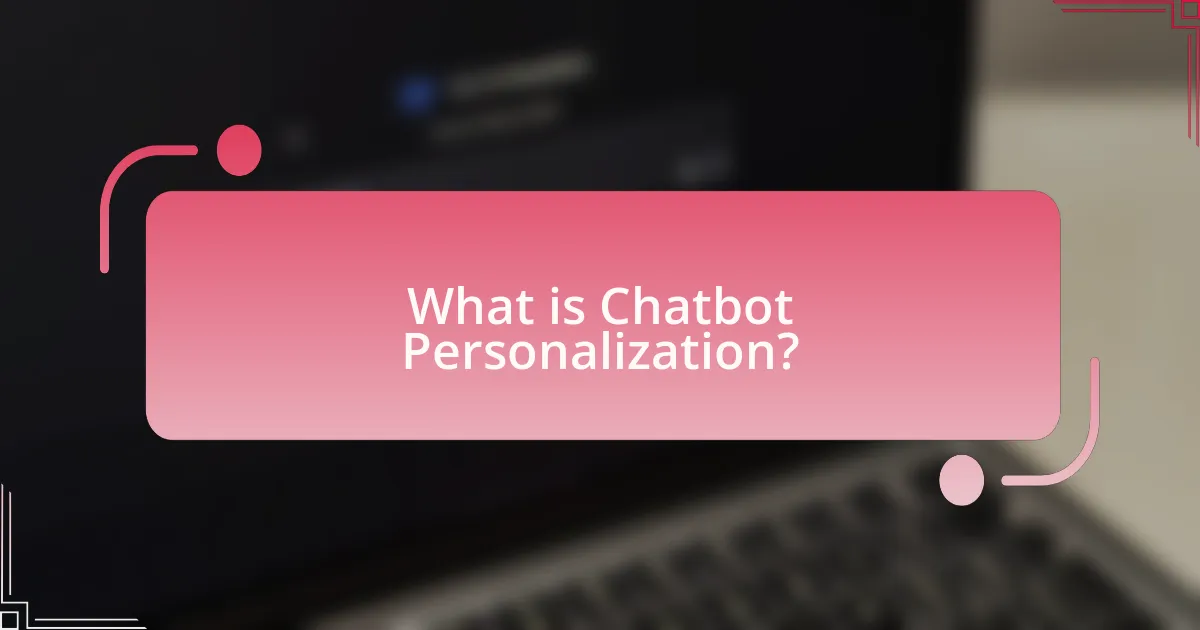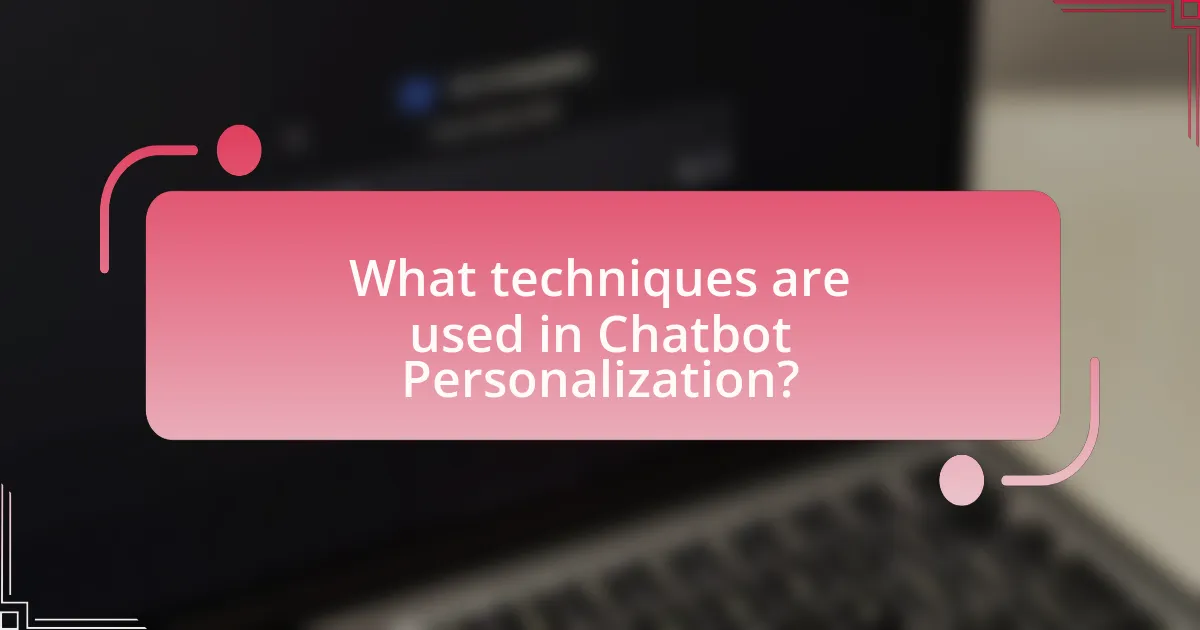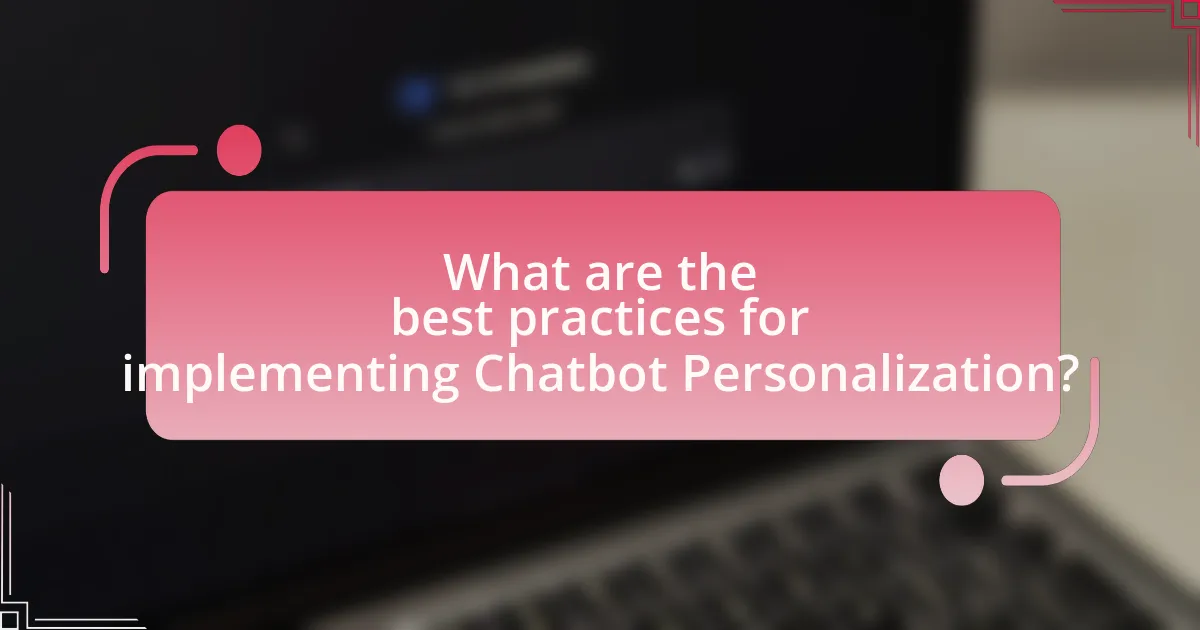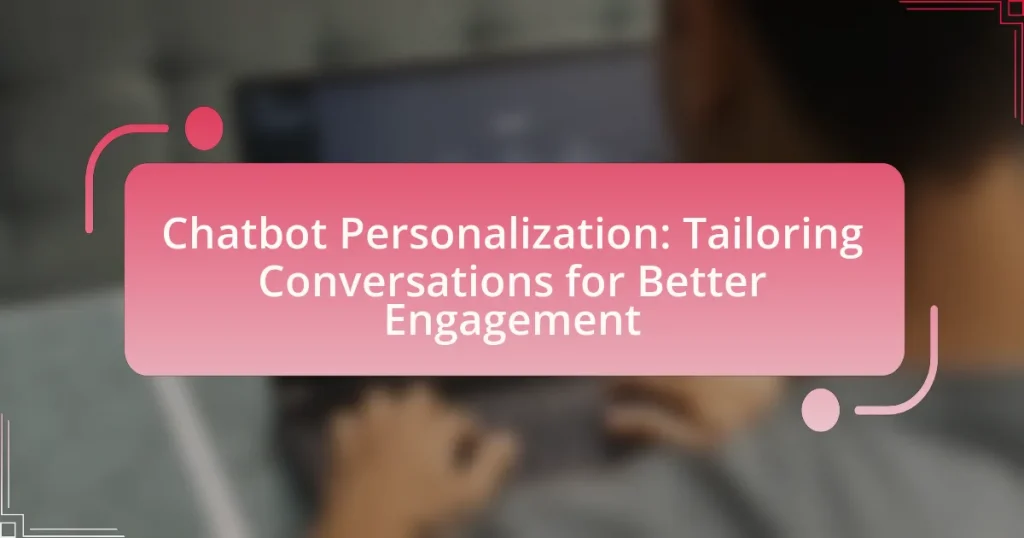Chatbot personalization is the process of customizing interactions between chatbots and users based on individual preferences, behaviors, and historical data, significantly enhancing user engagement and satisfaction. Key elements of effective personalization include user data utilization, contextual understanding, and adaptive responses, which collectively improve user retention and loyalty. Techniques such as user profiling, behavioral tracking, and machine learning play a crucial role in tailoring chatbot interactions, while best practices emphasize the importance of segmenting audiences and employing feedback loops. The article also addresses the challenges of over-personalization and data privacy risks, providing practical tips for improving chatbot personalization to foster deeper connections with users.

What is Chatbot Personalization?
Chatbot personalization refers to the process of customizing interactions between a chatbot and users based on individual preferences, behaviors, and historical data. This approach enhances user engagement by making conversations more relevant and tailored to the specific needs of each user. For instance, a study by Salesforce found that 70% of consumers expect personalized experiences from brands, indicating that personalization significantly impacts user satisfaction and loyalty.
How does Chatbot Personalization enhance user experience?
Chatbot personalization enhances user experience by delivering tailored interactions that meet individual user needs and preferences. Personalized chatbots utilize data such as user behavior, past interactions, and demographic information to create relevant responses, which increases user satisfaction and engagement. According to a study by Salesforce, 70% of consumers say a company’s understanding of their personal needs influences their loyalty, highlighting the importance of personalization in fostering positive user experiences.
What are the key elements of effective chatbot personalization?
The key elements of effective chatbot personalization include user data utilization, contextual understanding, and adaptive responses. User data utilization involves collecting and analyzing information such as user preferences, past interactions, and demographics to tailor conversations. Contextual understanding allows the chatbot to interpret the user’s intent and the context of the conversation, enhancing relevance. Adaptive responses enable the chatbot to modify its replies based on user behavior and feedback, ensuring a more engaging experience. These elements collectively improve user satisfaction and engagement, as evidenced by studies showing that personalized interactions can increase user retention rates by up to 30%.
How does user data influence chatbot personalization?
User data significantly influences chatbot personalization by enabling the chatbot to tailor interactions based on individual preferences, behaviors, and historical interactions. By analyzing user data such as previous conversations, feedback, and demographic information, chatbots can customize responses, recommend relevant products, and provide personalized support. For instance, a study by Salesforce found that 70% of consumers expect personalized experiences from brands, highlighting the importance of leveraging user data to enhance engagement and satisfaction. This data-driven approach allows chatbots to create a more relevant and effective communication experience, ultimately leading to improved user retention and loyalty.
Why is Chatbot Personalization important for engagement?
Chatbot personalization is important for engagement because it enhances user experience by providing tailored interactions that meet individual needs. Personalized chatbots can analyze user data, preferences, and past interactions to deliver relevant responses, which increases user satisfaction and retention. Research indicates that personalized experiences can lead to a 20% increase in customer satisfaction and a 10% boost in engagement rates, demonstrating the effectiveness of tailored communication in fostering deeper connections with users.
What impact does personalization have on user retention?
Personalization significantly enhances user retention by creating tailored experiences that meet individual preferences and needs. Research indicates that personalized interactions can increase user engagement by up to 80%, as users are more likely to return to platforms that recognize and cater to their specific interests. For instance, a study by Epsilon found that 80% of consumers are more likely to make a purchase when brands offer personalized experiences. This demonstrates that effective personalization not only fosters a sense of connection but also drives repeat usage, ultimately leading to higher retention rates.
How does personalization affect customer satisfaction?
Personalization significantly enhances customer satisfaction by creating tailored experiences that meet individual preferences and needs. When customers receive personalized interactions, such as recommendations based on their past behavior or preferences, they feel valued and understood, leading to increased loyalty and positive sentiment towards the brand. Research indicates that 80% of consumers are more likely to make a purchase when brands offer personalized experiences, highlighting the direct correlation between personalization and customer satisfaction.

What techniques are used in Chatbot Personalization?
Techniques used in chatbot personalization include user profiling, contextual understanding, and adaptive learning. User profiling involves collecting and analyzing data about users, such as preferences and past interactions, to tailor responses. Contextual understanding allows chatbots to interpret the context of conversations, enhancing relevance and engagement. Adaptive learning enables chatbots to improve over time by learning from user interactions, thereby refining their responses and suggestions. These techniques collectively enhance user experience and engagement by making interactions more relevant and personalized.
How can user preferences be integrated into chatbot conversations?
User preferences can be integrated into chatbot conversations by utilizing data collection methods such as user profiles, interaction history, and explicit feedback mechanisms. By analyzing this data, chatbots can tailor responses, recommend relevant content, and adjust their tone to align with individual user preferences. For instance, a study by McTear (2017) highlights that chatbots that adapt their language style based on user interactions significantly enhance user satisfaction and engagement. This approach not only personalizes the conversation but also fosters a more meaningful interaction between the user and the chatbot.
What methods are used to gather user preferences?
Methods used to gather user preferences include surveys, user feedback forms, behavioral tracking, and machine learning algorithms. Surveys and feedback forms directly solicit user input regarding their likes, dislikes, and desired features, providing explicit data on preferences. Behavioral tracking analyzes user interactions and engagement patterns, revealing implicit preferences based on actions taken within the chatbot environment. Machine learning algorithms further enhance this process by identifying trends and predicting user preferences based on historical data, allowing for more personalized interactions. These methods collectively enable chatbots to tailor conversations effectively, improving user engagement and satisfaction.
How can chatbots adapt to changing user preferences over time?
Chatbots can adapt to changing user preferences over time by utilizing machine learning algorithms that analyze user interactions and feedback. These algorithms enable chatbots to identify patterns in user behavior, preferences, and sentiment, allowing them to adjust responses and recommendations accordingly. For instance, a study by Google Research demonstrated that chatbots employing reinforcement learning could improve user satisfaction by 20% through personalized interactions based on historical data. By continuously learning from user inputs and adapting their conversational strategies, chatbots can maintain relevance and enhance user engagement over time.
What role does machine learning play in Chatbot Personalization?
Machine learning plays a crucial role in chatbot personalization by enabling the system to analyze user interactions and adapt responses accordingly. Through techniques such as natural language processing and predictive analytics, machine learning algorithms can identify user preferences, behaviors, and sentiment, allowing chatbots to deliver tailored experiences. For instance, a study by McTear (2017) highlights that machine learning enhances the ability of chatbots to learn from past conversations, improving their accuracy and relevance in future interactions. This adaptability leads to increased user satisfaction and engagement, as personalized responses resonate more effectively with individual users.
How does machine learning improve response accuracy?
Machine learning improves response accuracy by enabling chatbots to analyze vast amounts of conversational data and learn from user interactions. This process allows the models to identify patterns, understand context, and generate more relevant responses. For instance, a study by Google Research demonstrated that machine learning algorithms could enhance the accuracy of responses by up to 30% compared to rule-based systems, as they adapt to user preferences and conversational nuances over time.
What are the challenges of implementing machine learning in chatbots?
The challenges of implementing machine learning in chatbots include data quality, model complexity, and user expectations. Data quality is crucial, as machine learning models require large amounts of accurate and relevant data to learn effectively; poor data can lead to inaccurate responses. Model complexity poses a challenge because advanced algorithms may require significant computational resources and expertise to develop and maintain, which can be a barrier for many organizations. Additionally, user expectations can be difficult to manage, as users often anticipate human-like interactions, which can be hard to achieve with current technology. These challenges highlight the need for careful planning and resource allocation when integrating machine learning into chatbot systems.

What are the best practices for implementing Chatbot Personalization?
The best practices for implementing chatbot personalization include utilizing user data, segmenting audiences, and employing adaptive learning algorithms. Utilizing user data allows chatbots to tailor responses based on individual preferences and past interactions, enhancing user experience. Segmenting audiences helps in delivering targeted content and responses that resonate with specific user groups, thereby increasing engagement. Employing adaptive learning algorithms enables chatbots to improve over time by learning from user interactions, which leads to more relevant and personalized conversations. Research indicates that personalized experiences can increase customer satisfaction by up to 20%, demonstrating the effectiveness of these practices in enhancing engagement.
How can businesses effectively personalize chatbot interactions?
Businesses can effectively personalize chatbot interactions by utilizing user data to tailor responses and recommendations. By analyzing customer behavior, preferences, and past interactions, businesses can create a more engaging experience. For instance, a study by Salesforce found that 70% of consumers expect personalized experiences from brands, highlighting the importance of customization in enhancing user satisfaction. Additionally, implementing natural language processing allows chatbots to understand context and sentiment, further refining interactions. This approach not only improves customer engagement but also fosters loyalty, as personalized experiences lead to higher retention rates.
What strategies can be used to segment users for better personalization?
To segment users for better personalization, businesses can utilize demographic, behavioral, psychographic, and geographic strategies. Demographic segmentation involves categorizing users based on age, gender, income, and education, allowing for targeted messaging that resonates with specific groups. Behavioral segmentation focuses on user interactions, such as purchase history and engagement levels, enabling tailored experiences based on user activity. Psychographic segmentation considers users’ interests, values, and lifestyles, which helps in crafting messages that align with their motivations. Geographic segmentation targets users based on their location, facilitating localized content and offers. These strategies enhance personalization by ensuring that communications are relevant and engaging, ultimately leading to improved user satisfaction and loyalty.
How can feedback loops enhance chatbot personalization?
Feedback loops enhance chatbot personalization by continuously collecting user interactions and preferences to refine responses and improve user experience. This iterative process allows chatbots to adapt their behavior based on real-time data, ensuring that interactions become more relevant and tailored to individual users. For instance, a study by McTear (2017) highlights that chatbots utilizing feedback mechanisms can learn from user corrections and preferences, leading to a significant increase in user satisfaction and engagement. By analyzing user feedback, chatbots can adjust their language, tone, and content, ultimately fostering a more personalized and effective communication experience.
What common pitfalls should be avoided in Chatbot Personalization?
Common pitfalls to avoid in chatbot personalization include over-personalization, which can lead to privacy concerns, and under-personalization, resulting in generic interactions. Over-personalization may alienate users if they feel their data is being misused, as evidenced by studies showing that 86% of consumers are concerned about data privacy. Under-personalization fails to engage users effectively, as research indicates that 70% of consumers prefer personalized experiences. Additionally, neglecting to update personalization strategies can render chatbots outdated, as user preferences evolve over time.
How can over-personalization negatively impact user experience?
Over-personalization can negatively impact user experience by creating a sense of discomfort and invasion of privacy. When users receive highly tailored content that reflects extensive knowledge of their preferences and behaviors, they may feel monitored or manipulated, leading to distrust. Research indicates that 86% of consumers are concerned about data privacy, and excessive personalization can exacerbate these concerns, causing users to disengage from the platform. Additionally, over-personalization can limit exposure to diverse content, resulting in a narrow user experience that stifles exploration and discovery.
What are the risks of data privacy violations in chatbot personalization?
Data privacy violations in chatbot personalization pose significant risks, including unauthorized access to sensitive user information and potential misuse of personal data. These violations can lead to identity theft, financial fraud, and loss of user trust, which is critical for maintaining engagement. For instance, a study by the Ponemon Institute found that 60% of consumers would stop using a service after a data breach, highlighting the direct impact on user retention. Additionally, regulatory repercussions, such as fines under GDPR or CCPA, can arise from non-compliance with data protection laws, further emphasizing the importance of safeguarding user data in chatbot interactions.
What are practical tips for improving Chatbot Personalization?
To improve chatbot personalization, utilize user data effectively to tailor interactions. Collect and analyze user preferences, behaviors, and past interactions to create a more customized experience. Implement dynamic response generation that adapts based on user input, ensuring the chatbot can provide relevant suggestions and solutions. Additionally, incorporate natural language processing techniques to understand user intent better, allowing for more meaningful conversations. Research indicates that personalized interactions can increase user satisfaction by up to 30%, highlighting the importance of these strategies in enhancing engagement.










